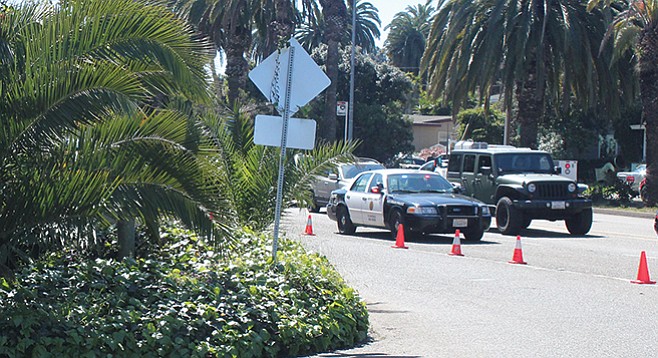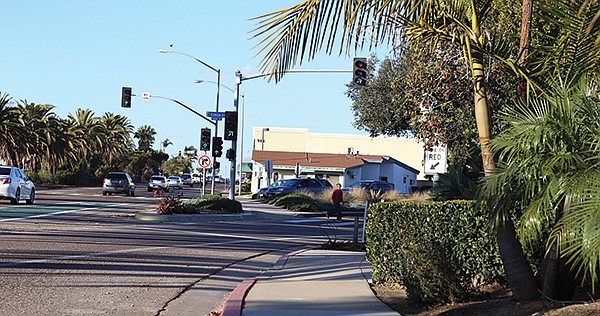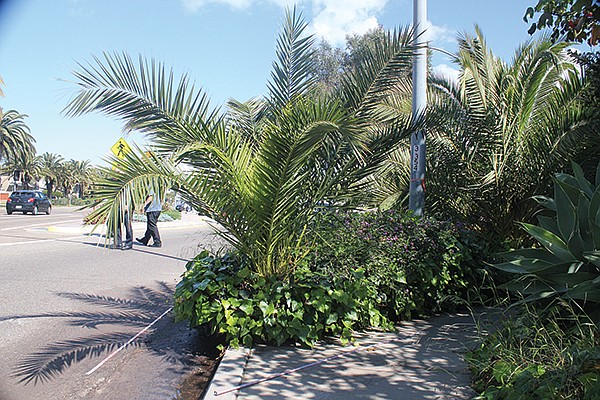 Facebook
Facebook
 X
X
 Instagram
Instagram
 TikTok
TikTok
 Youtube
Youtube

Point Loma residents had warned the city for over six years about the crosswalk located on Cañon Street being a potential death trap.

Tree limbs and overgrown bushes obstructed views for drivers and pedestrians. The transition ramp from Catalina Boulevard and the steep grade encouraged high vehicle speeds.
On March 2, 2015, residents’ fears came true.

On that day, during the morning commute at 6:25 a.m., David Hoban drove his black Chevy Suburban to work when he struck 56-year-old John Aavang as he and his seven-month-old daughter Juniper Aavang were crossing the street. Juniper’s mother, Ginerva Aavang stood a few feet behind and watched as the Suburban’s left fender collided into Juniper’s stroller, dragging it for 68 feet. Hoban, whom police said was not speeding at the time, rushed to help Juniper. He found she had abrasions on the back of her head. Her arm was broken and she struggled to breathe. She died later that morning.
John Aavang lay 68 feet away in the gutter. Blood trickled from his left ear. He had suffered a traumatic brain injury from the collision.
Nearly two years after the accident, attorneys for the Aavang family accuse the city and its attorneys of concealing evidence, committing perjury, and trying to block city officials from testifying under oath, including myor Kevin Faulconer, who then served as Point Loma’s council representative and still lives and cycles the area.
On February 23, attorneys for the Aavang family requested that a judge impose terminating sanctions, essentially stripping the city’s opportunity for a defense.
According to court documents obtained by the Reader, Aavang’s attorneys say opposing counsel has spent the better part of a year refusing to turn over evidence. And when emails are given, they have been heavily redacted and are illegible.
But, as evident in a March 17, 2015, public records request filed by the Reader, the city spent a much longer time trying to prevent evidence related to the crosswalk from surfacing.
Two weeks after the accident the Reader submitted a request to view any complaints from residents to Faulconer as well as internal documents between Faulconer’s office and San Diego’s traffic and engineering department. The city produced one complaint submitted by Point Loma resident Jon O’Connor in July 2010. O’Connor said the crosswalk was a “complete blind spot for families with kids trying to cross.”
Eight months later, O’Connor followed up: “The ladder crosswalk and signs are greatly appreciated,” he wrote. “However, we were almost run over again on Monday [morning] with over 20 cars driving by before someone stopped at the crosswalk. Something else has to be done at this intersection and it cannot wait another 120 days before somebody gets injured.“
But according to court documents filed by Aavang’s attorneys, O’Connor was not the only person to warn the city and Faulconer. As later revealed, two city employees who lived near the intersection also submitted complaints.
If not for one employee’s decision to speak to police on the day of Juniper Aavang’s death, those emails may have never seen the light of day. On March 2, 2015, hours after the accident, as police officers investigated, Richard Snapper, a 35-year former city employee who worked as the city’s personnel director and served as the assistant city manager, arrived at the scene and requested to speak to an officer. He wanted it in the official record that he had complained about the intersection nearly six years prior.
In a deposition given in the case, Snapper said he had attempted to use what he characterized as a crosswalk “fraught with peril” in 2009 during an afternoon walk.
“I mean, I’m an outdoor guy,” he added. “I would not even walk across it that second time I visited there. I chose to go to the middle of the block…rather than going to the crosswalk.”
Shortly after his walk, Snapper emailed then–director of engineering for the city, Patti Boekamp. However, Snapper — aware of what has come to be known as the city’s unwritten policy to avoid liability by refraining from mentioning safety issues in city emails — did not include the location but asked Boekamp to call him.
“I worked for the city,” Snapper later testified. “And I wasn’t going to put in, ‘I think this is dangerous’ and then identify a location. It just seemed to be prudent not to advertise a problem….”
Boekamp later instructed a city engineer to go investigate. The engineer later found that the crosswalk was not a safety risk.
But Snapper was not the only city employee to complain about poor visibility at the crosswalk. Former deputy city attorney Paige Hazard contacted Faulconer’s council office on February 2, 2013, requesting that someone “evaluate visibility” of the crosswalk. A field investigator inspected the crosswalk and determined that visibility was not an issue.
Police officers investigating the accident did not agree. In the March 2015 incident report, investigators found several obstructions for drivers and pedestrians that concealed views of oncoming traffic.
“It is my opinion that due to the obstructions caused by the palm trees, foliage, and traffic signal control box, it is not reasonable to assume that either party would have been able to see the other soon enough [to] prevent the collision from occurring,” wrote one of the investigators.
In the motion for terminating sanctions, attorneys for the Aavangs point to Snapper’s and Hazard’s testimony as evidence that the city committed perjury, hid documents, and violated the public records request.
“[We] have just recently confirmed the lengths to which [the city] has gone to hide critical percipient witness information and documents in this case. [The city] can provide no legitimate excuse for concealing Mr. Snapper’s and Ms. Hazard’s records and information. At all relevant times, [it] was aware of these witnesses, and was aware of the records and reports relating to these prior complaints; [the city] did not like the implications of producing this information so [it] tried to hide it. [The city’s] concealment is shocking, and directly contravenes the Discovery Act, the Brown Act, and the [California Public Records Act].”
As reported by the Reader, the city’s traffic and engineering department has attempted to prevent employees from discussing safety issues in city emails.
Former city engineer Farhad Bastani sued the city for wrongful termination after he was reprimanded for using city email to discuss safety issues. In one such email, former deputy director of field engineering David Zoumaras admonished Bastani for using email to report a safety hazard where a woman later was killed while crossing the street.
“In general, the city is subject to litigation which result from injuries to the public [sic],” explained Zoumaras. “Often the plaintiff alleges an unsafe condition, which the city was aware of before the injury. In the past the city has been hurt in court by email communications related to specific safety concerns, which were poorly written, contained erroneous information, and/or wrongly identified something as being a public safety concern. Since litigation and Public Records requests involve discovery of all documents/communications, we are protecting our employer and the people who pay for city services by being mindful of this.”
Attorneys for the Aavangs will ask a judge to impose the sanctions at a May 5 hearing.
Citing their clients’ privacy, attorneys for the Aavang family declined to comment for this story.


Point Loma residents had warned the city for over six years about the crosswalk located on Cañon Street being a potential death trap.

Tree limbs and overgrown bushes obstructed views for drivers and pedestrians. The transition ramp from Catalina Boulevard and the steep grade encouraged high vehicle speeds.
On March 2, 2015, residents’ fears came true.

On that day, during the morning commute at 6:25 a.m., David Hoban drove his black Chevy Suburban to work when he struck 56-year-old John Aavang as he and his seven-month-old daughter Juniper Aavang were crossing the street. Juniper’s mother, Ginerva Aavang stood a few feet behind and watched as the Suburban’s left fender collided into Juniper’s stroller, dragging it for 68 feet. Hoban, whom police said was not speeding at the time, rushed to help Juniper. He found she had abrasions on the back of her head. Her arm was broken and she struggled to breathe. She died later that morning.
John Aavang lay 68 feet away in the gutter. Blood trickled from his left ear. He had suffered a traumatic brain injury from the collision.
Nearly two years after the accident, attorneys for the Aavang family accuse the city and its attorneys of concealing evidence, committing perjury, and trying to block city officials from testifying under oath, including myor Kevin Faulconer, who then served as Point Loma’s council representative and still lives and cycles the area.
On February 23, attorneys for the Aavang family requested that a judge impose terminating sanctions, essentially stripping the city’s opportunity for a defense.
According to court documents obtained by the Reader, Aavang’s attorneys say opposing counsel has spent the better part of a year refusing to turn over evidence. And when emails are given, they have been heavily redacted and are illegible.
But, as evident in a March 17, 2015, public records request filed by the Reader, the city spent a much longer time trying to prevent evidence related to the crosswalk from surfacing.
Two weeks after the accident the Reader submitted a request to view any complaints from residents to Faulconer as well as internal documents between Faulconer’s office and San Diego’s traffic and engineering department. The city produced one complaint submitted by Point Loma resident Jon O’Connor in July 2010. O’Connor said the crosswalk was a “complete blind spot for families with kids trying to cross.”
Eight months later, O’Connor followed up: “The ladder crosswalk and signs are greatly appreciated,” he wrote. “However, we were almost run over again on Monday [morning] with over 20 cars driving by before someone stopped at the crosswalk. Something else has to be done at this intersection and it cannot wait another 120 days before somebody gets injured.“
But according to court documents filed by Aavang’s attorneys, O’Connor was not the only person to warn the city and Faulconer. As later revealed, two city employees who lived near the intersection also submitted complaints.
If not for one employee’s decision to speak to police on the day of Juniper Aavang’s death, those emails may have never seen the light of day. On March 2, 2015, hours after the accident, as police officers investigated, Richard Snapper, a 35-year former city employee who worked as the city’s personnel director and served as the assistant city manager, arrived at the scene and requested to speak to an officer. He wanted it in the official record that he had complained about the intersection nearly six years prior.
In a deposition given in the case, Snapper said he had attempted to use what he characterized as a crosswalk “fraught with peril” in 2009 during an afternoon walk.
“I mean, I’m an outdoor guy,” he added. “I would not even walk across it that second time I visited there. I chose to go to the middle of the block…rather than going to the crosswalk.”
Shortly after his walk, Snapper emailed then–director of engineering for the city, Patti Boekamp. However, Snapper — aware of what has come to be known as the city’s unwritten policy to avoid liability by refraining from mentioning safety issues in city emails — did not include the location but asked Boekamp to call him.
“I worked for the city,” Snapper later testified. “And I wasn’t going to put in, ‘I think this is dangerous’ and then identify a location. It just seemed to be prudent not to advertise a problem….”
Boekamp later instructed a city engineer to go investigate. The engineer later found that the crosswalk was not a safety risk.
But Snapper was not the only city employee to complain about poor visibility at the crosswalk. Former deputy city attorney Paige Hazard contacted Faulconer’s council office on February 2, 2013, requesting that someone “evaluate visibility” of the crosswalk. A field investigator inspected the crosswalk and determined that visibility was not an issue.
Police officers investigating the accident did not agree. In the March 2015 incident report, investigators found several obstructions for drivers and pedestrians that concealed views of oncoming traffic.
“It is my opinion that due to the obstructions caused by the palm trees, foliage, and traffic signal control box, it is not reasonable to assume that either party would have been able to see the other soon enough [to] prevent the collision from occurring,” wrote one of the investigators.
In the motion for terminating sanctions, attorneys for the Aavangs point to Snapper’s and Hazard’s testimony as evidence that the city committed perjury, hid documents, and violated the public records request.
“[We] have just recently confirmed the lengths to which [the city] has gone to hide critical percipient witness information and documents in this case. [The city] can provide no legitimate excuse for concealing Mr. Snapper’s and Ms. Hazard’s records and information. At all relevant times, [it] was aware of these witnesses, and was aware of the records and reports relating to these prior complaints; [the city] did not like the implications of producing this information so [it] tried to hide it. [The city’s] concealment is shocking, and directly contravenes the Discovery Act, the Brown Act, and the [California Public Records Act].”
As reported by the Reader, the city’s traffic and engineering department has attempted to prevent employees from discussing safety issues in city emails.
Former city engineer Farhad Bastani sued the city for wrongful termination after he was reprimanded for using city email to discuss safety issues. In one such email, former deputy director of field engineering David Zoumaras admonished Bastani for using email to report a safety hazard where a woman later was killed while crossing the street.
“In general, the city is subject to litigation which result from injuries to the public [sic],” explained Zoumaras. “Often the plaintiff alleges an unsafe condition, which the city was aware of before the injury. In the past the city has been hurt in court by email communications related to specific safety concerns, which were poorly written, contained erroneous information, and/or wrongly identified something as being a public safety concern. Since litigation and Public Records requests involve discovery of all documents/communications, we are protecting our employer and the people who pay for city services by being mindful of this.”
Attorneys for the Aavangs will ask a judge to impose the sanctions at a May 5 hearing.
Citing their clients’ privacy, attorneys for the Aavang family declined to comment for this story.
Comments